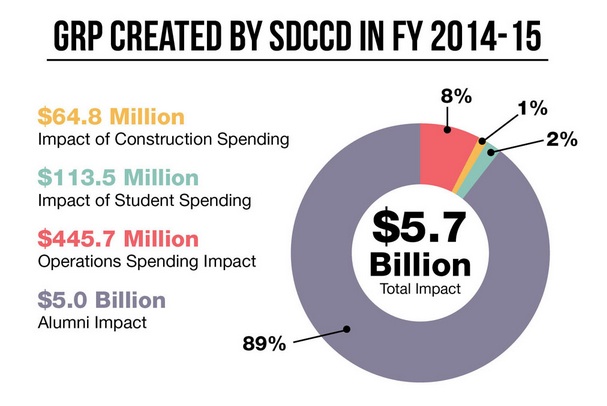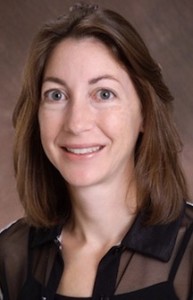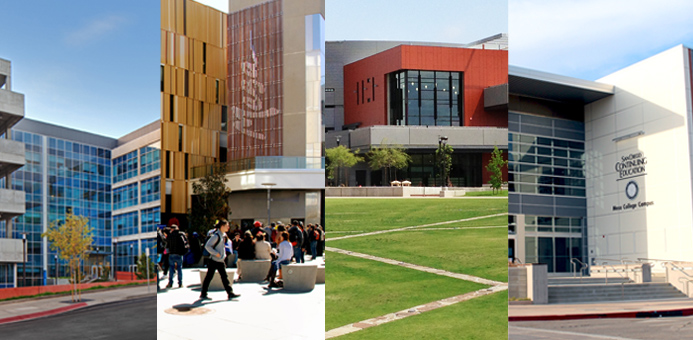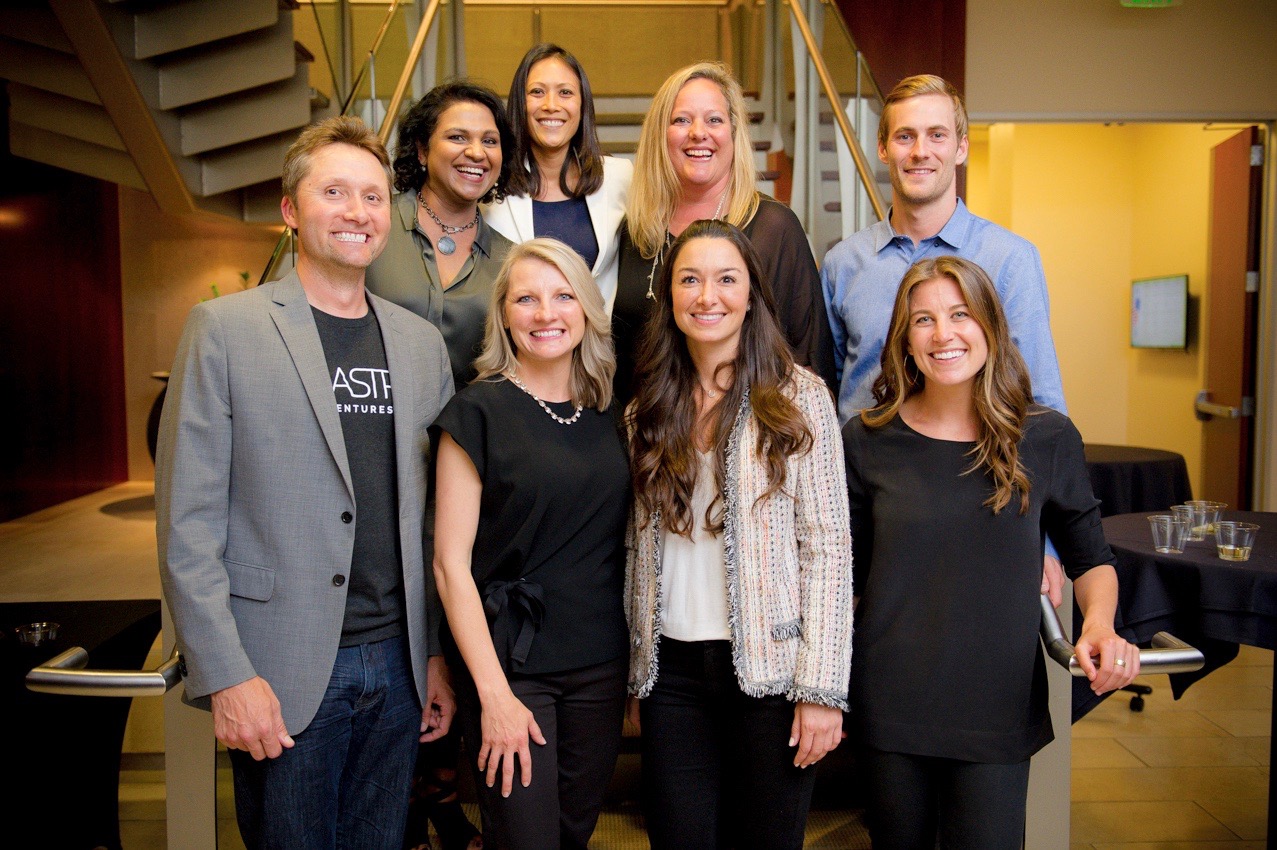Daily Business Report-Sept. 29, 2015
San Diego Community College District is the second largest district in California.
San Diego Community College District
Economic Impact Put at $5.7 Billion
The San Diego Community College District’s economic impact in San Diego County hit $5.7 billion last year, up from $5.2 billion in 2013-14. In total, the district’s economic impact is equal to 3.1 percent of the county’s gross regional product, according to a new analysis by Idaho-based Economic Modeling Specialists International.
The analysis looked at spending by the district on everything from payroll to construction, in addition to the higher wages and spending from current and former students that is attributed to the education they received at the district.
The district includes San Diego City College, San Diego Mesa College, San Diego Miramar College and San Diego Continuing Education.

According to the analysis, the district employed 4,760 full-time and part-time faculty and staff last year, 95 percent of whom lived in San Diego County. Total payroll was $237.2 million, much of which was spent in the region for food, clothing, housing, and entertainment, while the overall impact of operations spending reaching more than $445 million. Construction spending attributed to voter-approved Propositions S and N added an additional $64.8 million and created 875 new jobs.
The accumulated impact of former students currently employed in the San Diego County workforce amounted to $5 billion in the Gross Regional Product, which is equivalent to creating 71,223 new jobs, according to the analysis. The district is the region’s largest provider of workforce training.
“From manufacturing to software to life sciences, the district trains and guides the talent in industries that matter most to San Diego’s innovation economy,” said Mark Cafferty, president and CEO of San Diego Regional EDC. “This report reconfirms something we say time and time again: Investing in our community colleges means investing in our economy.”
Among the EMSI findings:
• Taxpayers provided $334.5 million of state and local funding to the district, and will receive an estimated present-day value of $1.6 billion in added tax revenue stemming from students’ higher lifetime incomes and the increased output of businesses at which they work.
______________________________________________________
Scientist Wins $1.5 Million Grant
To Investigate Sense of Smell

The brain can process a seemingly unlimited number of odors, yet most research in animal models has focused on just 10 “sample” odor molecules to track neurological activity from the nose into the brain.
Now the National Science Foundation (NSF) has awarded more than $1.5 million to Lisa Stowers, associate professor at The Scripps Research Institute (TSRI), to support research using 1,000 odor molecules.
“We’ve been limited by the odors commonly used in research,” said Stowers. “Understanding how the brain processes these odors will provide a good model for understanding how the brain accomplishes even more complex tasks, such as cognition.”
The new three-year study is part of a nationwide effort supported by the NSF to better understand how odors influence behavior and how the brain processes many kinds of environmental cues.
Stowers will work closely with lab heads at Duke University; the University of California, Los Angeles; the University of Utah; Rockefeller University; and Pennsylvania State University.
“The team aspect is going to be critical,” Stowers said. “It’s a really diverse group, where each lab has its unique strengths.”
Cal State San Marcos to Offer
Degree in Speech-Language Pathology
California State University San Marcos, responding to a growing need for undergraduate training in speech-language pathology, will launch a Bachelor of Science in Speech-Language Pathology (SLP) in fall 2016. Applications will be accepted starting Oct. 7 of this year.
Speech-language pathologist is ranked among the Top 100 Best Jobs for 2015 (No. 30) according to US News and World Report. The Bureau of Labor Statistics predicts a growing need for speech-language pathologists as the baby boomer generation ages and awareness of speech and language disorders in children grows. In 2020, almost 50 percent of school-based speech-language pathologists in the U.S. will be eligible for retirement, creating a massive need for qualified practitioners.
Students who graduate with a bachelor’s in SLP may continue on to the highly popular Master of Science in SLP offered at CSUSM. The bachelor’s program will teach critical content required for entry into the master’s program. After graduating, students must complete a clinical fellowship year and pass the national Praxis exam before becoming a practicing speech-language pathologist.
For more information, click here, or call (760) 750-4004.
Funding Renewed for Collaborative
Cancer Health Program for Hispanics
A collaborative program aimed at reducing the burden of cancer among Hispanic/Latinos in San Diego and Imperial counties through research and community outreach has received a $13 million grant from the National Cancer Institute, part of the National Institutes of Health.
The five-year grant renews funding for a partnership started in 2008 between San Diego State University and Moores Cancer Center at UC San Diego Health.
The SDSU/UCSD Cancer Center Comprehensive Partnership will support 30 joint research projects, research education programs for undergraduate students of underrepresented racial and ethnic groups who are studying cancer and cancer disparities as well as collaborations with community partners, researchers and students.
The SDSU/UCSD Cancer Center Comprehensive Partnership is headed by
Maria Elena Martinez, UC San Diego School of Medicine professor of family medicine, and Elva Arredondo, San Diego State University associate professor in the Graduate School of Public Health.

International Project Tracks
Beach Pollution Dynamics
In an ambitious binational effort to investigate how pollution and other contaminants travel across and along beach waters, scientists from both sides of the border are leading a novel experiment at Imperial Beach and Coronado and Tijuana, Mexico. The National Science Foundation-funded project includes researchers from UC San Diego’s Scripps Institution of Oceanography, Jacobs School of Engineering, and several Mexican institutions.
During the Cross Surfzone/inner-shelf Dye Exchange project, from Sept. 22 to Oct. 17, researchers will perform three experiments releasing non-toxic bright pink fluorescent dye into beach waters and track its movements along the coast some 10-20 kilometers (6.2-12.4 miles) for nearly 36 hours. One of the dye releases will be at the southern end of Playas de Tijuana, Mexico. A team of scientists, engineers, and technicians will follow the dye with a variety of instruments to obtain a clearer picture of how pollution moves and dilutes along the coast. With this information, study results will eventually be used by managers and policy makers to guide beach closure decisions and evaluate upstream mitigation possibilities.

Mobile App Records Erratic Eating Habits
Salk scientists show how timed feeding could help fight ‘metabolic jetlag’
Breakfast, lunch and dinner? For too many of us, the three meals of the day go more like: morning meeting pastry, mid-afternoon energy drink and midnight pizza. In Cell Metabolism, Salk Institute scientists present daily food and beverage intake data collected from over 150 participants of a mobile research app over three weeks. They show that a majority of people eat for 15 hours or longer, with less than a quarter of the day’s calories being consumed before noon and over a third consumed after 6 p.m.
The purpose of the app is to pilot a way to objectively study the effects of timing food intake in humans. Primed with evidence of how long people eat each day, senior author Satchidananda Panda — an associate professor in the Salk Institute’s Regulatory Biology Laboratory — along with first author Shubhroz Gill were able to test whether reducing this daily duration impacts health. In addition to cutting out some bad habits, the authors hypothesized that a timed feeding schedule could prevent “metabolic jetlag” – when differences in day-to-day or weekday/weekend meal times cause metabolic organs to become out of sync with the body’s overall circadian rhythms.
Babies Time Their Smiles to Make
Their Moms Smile in Return

Why do babies smile when they interact with their parents? Could their smiles have a purpose? In the Sept. 23 issue of PLOS ONE, a team of computer scientists, roboticists and developmental psychologists confirm what most parents already suspect: when babies smile, they do so with a purpose — to make the person they interact with smile in return.
In addition, babies reach that goal by using sophisticated timing, much like comedians who time their jokes to maximize audience response. But there is a twist: babies seem to be doing this while smiling as little as possible.
Researchers detail their findings in an innovative study that combines developmental psychology, computer science and robotics — an approach that has never been tried before, to the best of the researchers’ knowledge. The study is part of an effort funded by the National Science Foundation to use robots to better understand human development. It gives developmental psychologists a tool for studying non-verbal children and adults, such as those with autism, researchers said.
To verify their findings, researchers programmed a toddler-like robot to behave like the babies they studied and had the robot interact with undergraduate students. They obtained the same results: the robot got the undergraduates to smile as much as possible, while smiling as little as possible.
“If you’ve ever interacted with babies, you suspect that they’re up to something when they’re smiling. They’re not just smiling randomly,” said Javier Movellan, a research scientist in the Machine Perception Laboratory at the University of California, San Diego, and one of the study’s authors. “But proving this is difficult.”
To find out what babies are really up to, researchers turned to optimal control theory, a tool often used in robotics. The method allows researchers to design and program robots to perform a specific behavior based on specific goals. In this study, the researchers used the method to reverse engineer what the babies’ goals were based on their behavior.
Whole Foods Market Cutting
Jobs Across the Board
City News Service

Whole Foods Market, which has locations in Del Mar, La Jolla and Encinitas, plans to eliminate about 1,500 jobs, or about 1.6 percent of its workforce, over the next two months, the Texas-based company announced Monday.
Company officials said many of the cuts are expected to be achieved through attrition — not filling jobs that workers vacate — and some of the people whose jobs are eliminated could find work at other open positions or at one of the more than 100 new stores in development.
“This is a very difficult decision, and we are committed to treating affected team members in a caring and respectful manner,” Whole Foods co-CEO Walter Robb said. “We have offered them several options including transition pay, a generous severance or the opportunity to apply for other jobs.
“In addition, we will pay these team members in full over the next eight weeks as they decide which option to choose,” he said. “We believe this is an important step to evolve Whole Foods Market in a rapidly changing marketplace.”
The company did not provide a breakdown of where the jobs would be cut and which stores might be affected. Company officials said the cuts were being made as part of its “commitment to lower prices for its customers and invest in technology upgrades while improving its cost structure.”
The company has a total of 431 stores, including 10 in Canada and nine in the United Kingdom.
L.A. Lawyer Wants City to Redo
Stadium Environmental Study
City News Service
Los Angeles-area lawyer wants the city of San Diego to completely restart its environmental study of a proposed stadium project in Mission Valley, according to documents made available to City News Service Monday.
The demand from attorney Douglas Carstens of Hermosa Beach was among public comments submitted Friday regarding a draft environmental impact report compiled for the project, designed to replace aging Qualcomm Stadium and keep the Chargers from leaving for Los Angeles.
Friday was the deadline for the public to comment on the draft EIR. A total of 18 submissions were received — many offering technical remarks and questions, but some were critical regarding the document.
“EIRs typically generate a wide range of comments so we expected to see a broad spectrum of responses,” said Craig Gustafson, a spokesman for San Diego Mayor Kevin Faulconer. “After 45 days of public review, the city received fewer than 20 comments, which included supportive letters from local agencies as well as feedback from a Los Angeles area law firm.”
Carstens wrote that “extensive deficiencies” pervade the draft EIR, including “a vague and unstable” project description and a failure to analyze, disclose and resolve many environmental impacts.
He said the city needs to restart the entire environmental process.
Predatory Towing Victims to be Reimbursed
113 motorists whose vehicles were illegally towed from the Plaza del Sol shopping center in Kearny Mesa over an eight-month period will get reimbursement checks totaling $34,580 resulting from the prosecution of NK Towing, its owner, Amir Iravani, and a Vista man, the City Attorney’s Office said today.
According to the criminal complaint, the Vista man, Elvin Vega, requested and then sought commissions from the towing company for unauthorized tows. NK Towing agreed to reimburse the tow fees. Vega pleaded guilty last week to unauthorized towing, a misdemeanor, and was placed on three years’ probation by Superior Court Judge Lisa Rodriguez and ordered to pay court-imposed fines and fees.
The complaint alleged that Vega did not have authority from the shopping center’s manager or property owner to request tows from the parking lot. Such authority is required by law.
The California Vehicle Code prohibits the receipt of any compensation, direct or indirect, from a towing company in exchange for requesting its services.

Bud Kearns Pool Reopens
The popular Bud Kearns Pool in Balboa Park opened Monday after being shut down for months for repairs to its main drain line. It was closed in February.
North Park residents and others who would normally be cooling off at the pool were disappointed this swim season as the facility remained closed well-past its usual April opening.
According to Tim Graham, senior public information officer for the city of San Diego, the city conducted a comprehensive inspection of the pump room and detected an overly calcified eight-inch main drain. The problem was causing pump motors and impellers to malfunction and burn out.
Cost of the repairs was put at $149,000.



